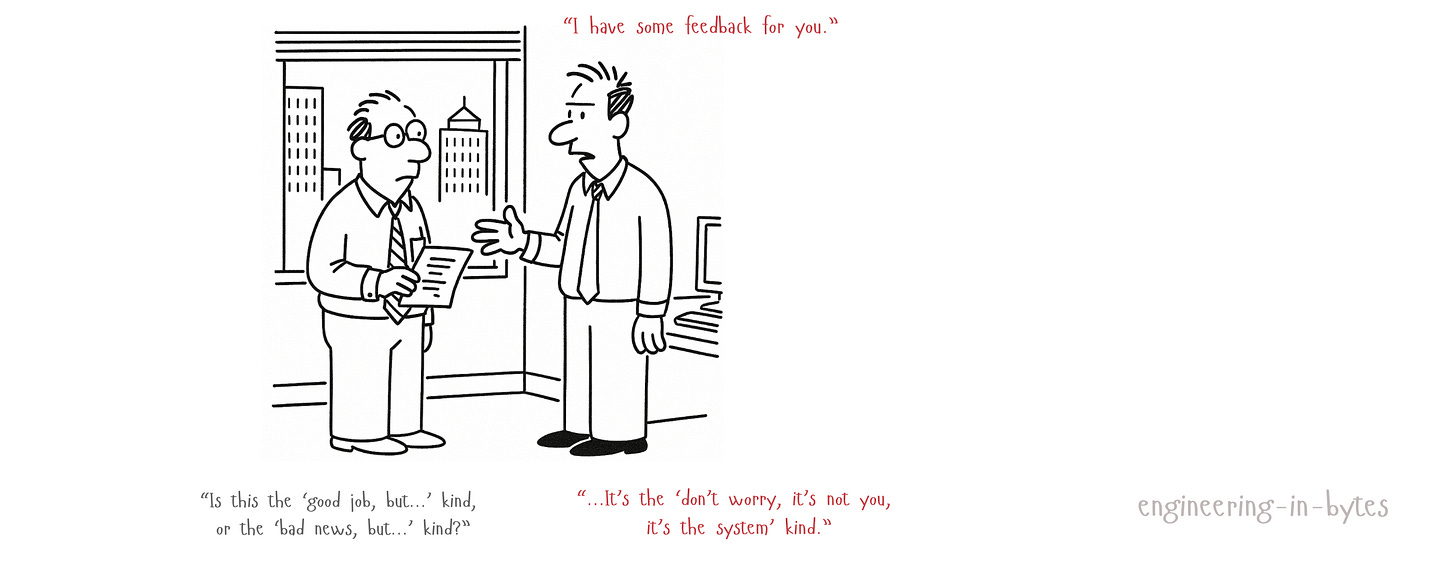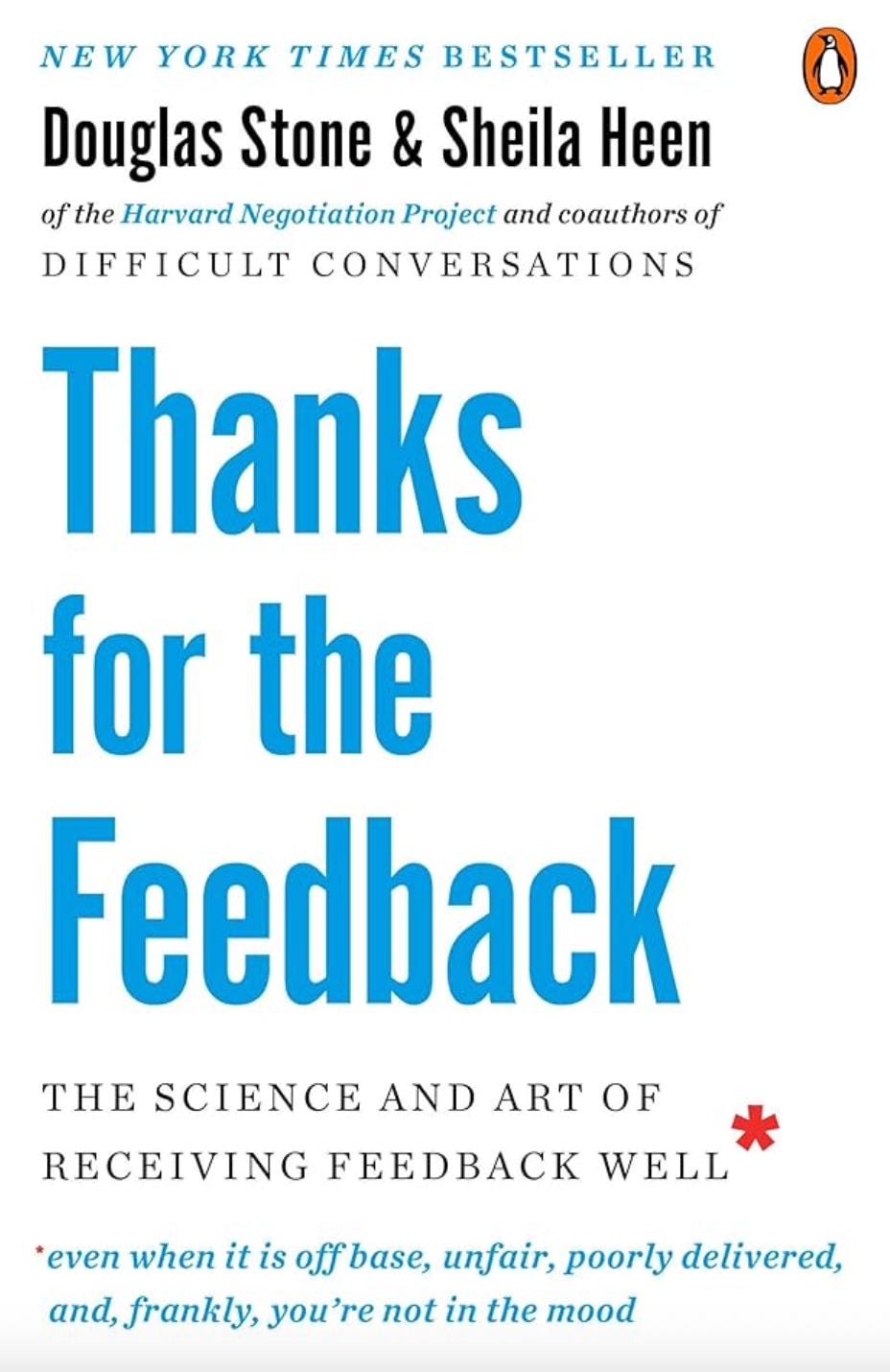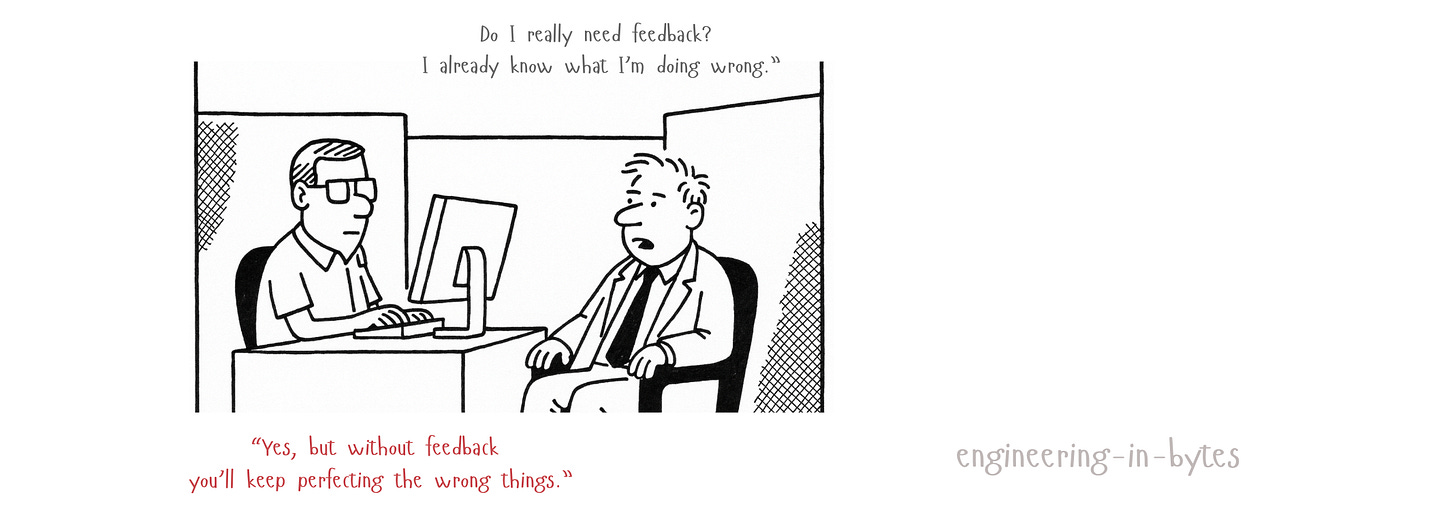"Average players want to be left alone. Good players want to be coached. Great players want to be told the truth."
— Doc Rivers
Why feedback matters more than we think
Last week we spoke about trust. Trust is the base. Without trust, even the most carefully prepared feedback feels like criticism. With trust, feedback feels like care. It feels like someone is investing in you, not tearing you down.
Feedback is one of the most powerful tools we have as leaders. But it is also one of the most misunderstood. Too many of us think of feedback only during performance reviews or promotion cycles. The once-a-year conversation, the long slide deck, the checklist of “strengths” and “areas to improve.” But real leadership is not about one big conversation. It is about the small, everyday ones.
Feedback happens in the code review where you ask, “Why this approach?” It happens after a meeting where you say, “Next time, slow down so everyone can follow.” It happens in the moment when you thank someone for staying calm during an outage. Feedback, in its best form, is not a thunderstorm that arrives once a year. It is the daily weather. It is the light, steady rain that makes growth possible.
Why feedback feels so heavy
Even though we all agree feedback is important, most leaders hesitate. I know I did. Giving feedback feels heavy because we fear the reaction. Will this hurt their feelings? Will they push back? Do I even have the right words to say it kindly?
And sometimes, the truth is, we avoid giving feedback because we never received it in a good way ourselves. Many of us grew up in workplaces where “feedback” meant blame, judgment, or a surprise in a yearly review. We carry those scars, and we fear passing them on.
But silence is not neutral. Silence is also feedback. Silence tells your team: “Everything is fine.” Silence tells them: “Keep doing exactly what you’re doing.” The danger is that silence lets small problems grow into bigger ones. And when they finally explode, the correction feels harsher than it needed to be.
Feedback delayed is not just growth delayed. Feedback delayed is trust delayed.
A simple story
Let me share a small scene.
A senior engineer gave a demo to leadership. The content was strong. The research was deep. But the slides were too many, the details too heavy. The audience drifted. Attention dropped.
Now as a leader, you had two choices. You could say nothing, smile, and move on. Or you could step in gently:
“Your preparation was very clear. One suggestion—try fewer slides next time so people stay with you.”
That one sentence can change the next presentation. It does not shame the person. It shows you care. It tells them: I want you to succeed in the next room, not just survive in this one.
And the bigger effect? The team learns that feedback is safe. It is not a trap. It is not about blame. It is about making each other better.
How to give feedback without breaking people
Good feedback is not about power. It is about care. And the way you deliver it makes all the difference.
Give it in private. Always. Public praise lifts people. Public correction shames people. If something needs to be corrected, do it in a 1:1. Even a small comment—“slow down in your explanations”—lands softer and more useful when spoken in private. Your team will remember that you protected their dignity.
Be specific. “Good job” is pleasant but vague. “Good job simplifying the migration risks” tells them exactly what to keep doing.
Be timely. Feedback weeks later is memory, not feedback. Speak soon, while the details are still alive.
Talk about behavior, not the person. “The meeting went long” is easier to act on than “you always talk too much.” Behavior can change; personality cannot.
And above all, show your intent. Feedback works when people know you are on their side. If the words are tough but the intent is clear, trust grows instead of shrinking.
Receiving feedback is even harder
We often talk about giving feedback, but receiving it may be even harder. The first instinct when someone gives us feedback is to defend, explain, or argue. I know this because I have done it. Many times.
But real growth starts when we learn to listen without fighting.
When someone gives you feedback:
Pause. Let them finish.
Thank them. Even if it stings.
Take one action. Not five. One small step you can really do.
And then later, go back and tell them what changed. That simple loop builds a culture where feedback goes both ways.
A book that changed how I see feedback
One book that deeply influenced me is Thanks for the Feedback by Douglas Stone and Sheila Heen. This is not a book about how to give feedback—it is about how to receive it. And that is a shift we rarely talk about.
The book explains that feedback comes in three forms: appreciation, coaching, and evaluation. If you mix them, people get confused. If someone needs coaching but hears evaluation, they become defensive. If they need appreciation but only hear coaching, they feel unseen.
The book also explains the three “triggers” that make us resist feedback: the truth trigger (“this feedback is wrong”), the relationship trigger (“why from you”), and the identity trigger (“what does this say about me as a person?”).
The lesson is simple but powerful: feedback always lands on a human being, with emotions, fears, and pride. To make it work, we must name the type, separate the triggers, and keep the message specific.
When I read this, I realized feedback is not only about the giver being clear. It is also about the receiver being open. That balance changes everything.
A framework you can adopt from the book
Reading is good, but using the lessons is better. Here is a simple way you can turn the book’s ideas into daily practice with your team.
Name the type of feedback. Before you speak, say it: “This is coaching.” Or “This is evaluation.” Or “This is appreciation.” It clears confusion. The person knows how to listen.
Start with care. Begin by showing your intent. “I want you to succeed as a lead.” “I want you to be ready for the next level.” This opens the door.
Add the context. Name the moment. “In yesterday’s demo.” “In the design review this morning.” Specific moments make the feedback feel real, not abstract.
Describe the behavior. Say what you saw or heard. “You interrupted twice.” “You skipped the trade-off section.” Stick to what happened, not who they are.
Explain the impact. Connect it to the team or outcome. “After you interrupted, the quieter voices stopped speaking.” “When you skipped trade-offs, the decision felt rushed.”
Offer one next step. Feedback is not finished until you show a way forward. “Next time, let’s hold questions until the end.” “Add a single slide with trade-offs.” Small, clear steps make change possible.
Invite feedback back. End with openness. “What is one thing I should change in how I run these reviews?” When leaders also ask, the culture shifts.
This framework may feel slow at first, but with practice it becomes natural. The flow—type → care → context → behavior → impact → next step → invitation—turns feedback from something people fear into something they value.
Why this matters
Feedback is how we raise standards without breaking trust. It is how people know they are seen—not only when they succeed but also when they stumble. It is how leaders show they believe their people can grow stronger, not just stay the same.
The best leaders I know do two things consistently: they give feedback with speed and respect, and they receive feedback with calm and humility. They know feedback is not a weapon. It is a gift. And like all gifts, it matters most when it is given often, in small and thoughtful ways.
Feedback is not about pointing out weakness. It is about pointing toward growth.
Next week: Leading through change (and failure) — how to keep your team steady when the ground shifts, and how to turn a bad week into a learning week without burning people out.






